Menus
- Experience over 50,000 kilometers
- Video: Used advice on the Honda Africa Twin
- Over half with dual clutch transmission
- equipment
- Inspections
- Balance after 50,000 kilometers
- Honda opinion
- Reading experiences
- Price comparison Honda Africa Twin
- Price comparison for used Honda CRF1000L Africa Twin
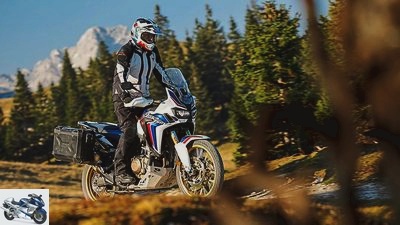
Jorg Kunstle

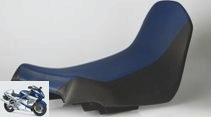
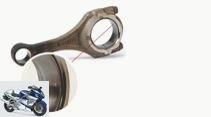

39 photos
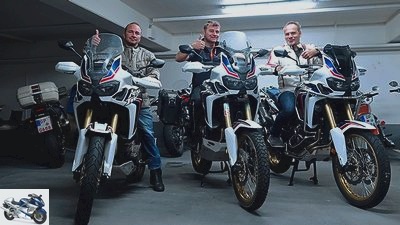
Markus Biebricher
1/39
End: Reporter Mike Schumann (left) and travel uncle Markus Biebricher (right) escorted the MOTORRAD long-term test twin with their private Africa Twins for the final dismantling.
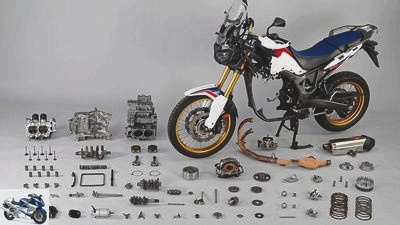
Jacek Bilski
2/39
After 50,000 kilometers of endurance test, the Africa Twin has to expand its core. The endurance test also includes accessories such as an exhaust, luggage system, windshield and tires. You can see all tested articles + conclusion in this picture gallery.
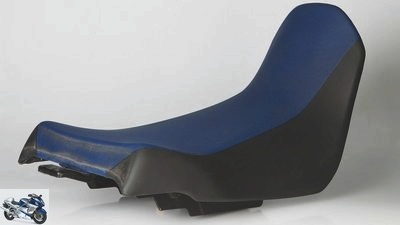
Jacek Bilski
3/39
Many Africa Twin owners complain about the bench that quickly sagged. The long-term test bench also became uncomfortable early on. In this picture gallery there are also recommendations for seats.
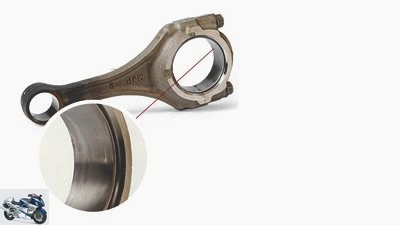
Jacek Bilski
4/39
The shells of the connecting rod bearings hide the fact that they have many millions of revolutions behind them. There are hardly any tracks.

Jacek Bilski
5/39
In a mechanism on which there are hardly any signs of use, a groove on one (single) cam is only noticeable. Nevertheless: the tracks are insignificant.
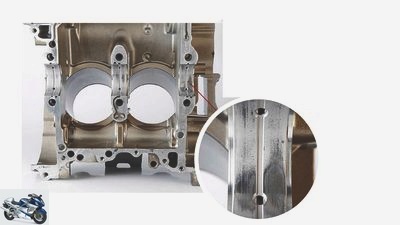
Jacek Bilski
6/39
The conception as an in-line twin not only saves costs, but also creates space for the tank and air filter. The cylinders are in almost new condition.
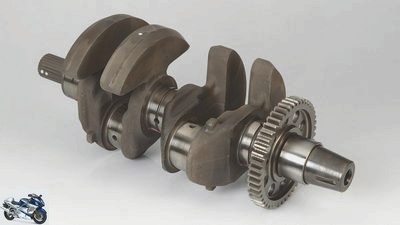
Jacek Bilski
7/39
Is an in-line twin, but it sounds like a V2: The crank pins of the crankshaft (above) are offset by 270 degrees. The tracks on the bearing shells (left) are visible, but insignificant.
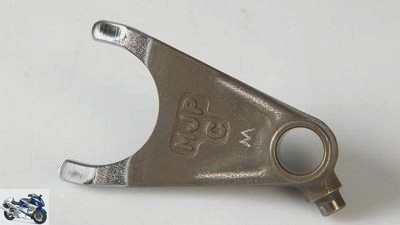
Jacek Bilski
8/39
You have to look for tracks on the almost intact shifting claws. By the way: 52 percent of all Africa Twin are in Germany …
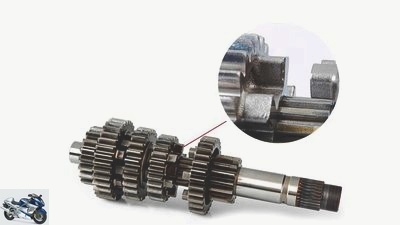
Jacek Bilski
9/39
… ordered with the automatically shifting dual clutch transmission. The traces of wear are also only marginal in the conventional transmission of the endurance tester.
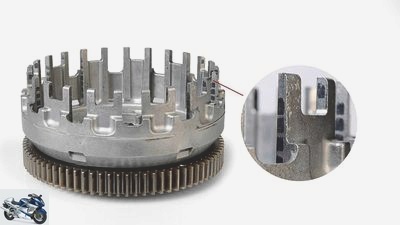
Jacek Bilski
10/39
The chatter marks on the clutch basket are limited to the visual impression. The notches are minimal and the clutch was easy to dose right up to the end.
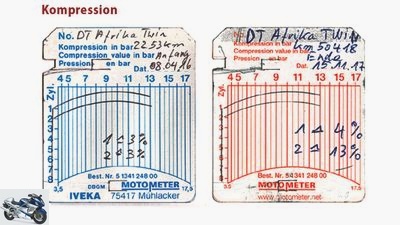
11/39
The increased pressure loss in cylinder two is due to the slight leak in one of the exhaust and intake valves.
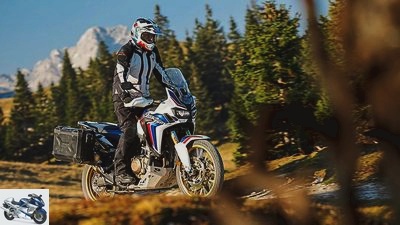
Jorg Kunstle
12/39
Great: On gravel, the Africa Twin is the boss – at least that of all travel enduros.
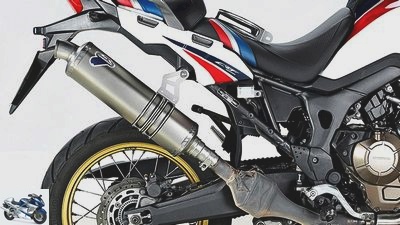
mps photo studio
13/39
Termignoni Titan: As the supplier to the Honda Dakar team, Termignoni gives the Africa Twin a bit of racing flair. The titanium exhaust turned out to be sporty and light at 3.0 kg. Its fit could be better though. The rubber band under the fastening clamp is difficult to assemble, the fastening does not succeed without tension. After all, the Italian damper pays back with a small increase in performance between 4,000 and 6,000 rpm. Weight: 3.0 kg, power: 96 hp, price: 579 euros.
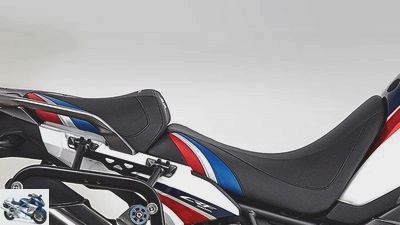
mps photo studio
14/39
Bagster Serie speciale bench seat, 380 euros: The color-coordinated cover is eye-catching, the firm upholstery is pleasing, but the deep seat recess cements the driver in his position. In the long run this can lead to uncomfortable pressure points. Bagster offers made-to-measure seat heights and gel inserts for a surcharge. Conclusion: Compared to the series state, the Bagster hardly offers better seating comfort.
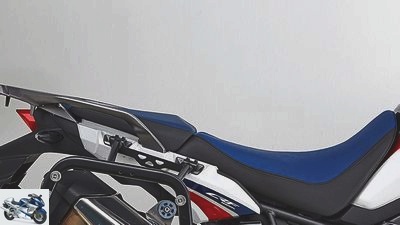
mps photo studio
15/39
Bench: Jungbluth, from 225 euros: Jungbluth knows where things are going on the long haul. If you are initially surprised by the very firm upholstery, the seat shows its trump cards after hours. Fatigue-free and pressure-free sitting are possible even after many kilometers. In contrast to the Bagster, you have to send in your own bench for the revision. Conclusion: firm upholstery, but very comfortable in the long run.
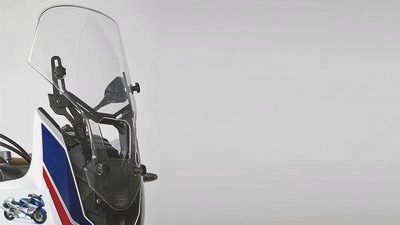
mps photo studio
16/39
Window adjustment: Roth, 79 euros: With the additional frame from inventor Wolfgang Roth, the standard window can be individually adjusted over a range of 60 millimeters. Even in the fully extended position and at top speed, the frame remains stable. In terms of price, at 79 euros it is an extremely fair offer anyway. Conclusion: easy adjustability, inexpensive – a clear tip.
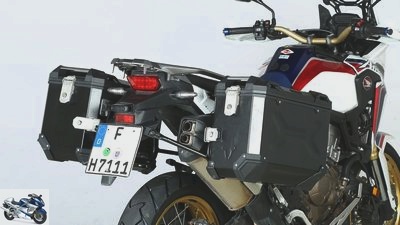
mps photo studio
17/39
Case system: SW-Motech Trax Evo, 750 euros: Honda has calculated the elegant original cases for the Africa Twin cheaply (30/40 liters, 645 euros), but rustic luggage systems can still emphasize the twin’s adventure character. A good alternative: the Trax Evo cases from SW-Motech. In addition to the large volume (either 37 or 45 liters, same price), the aluminum cases impress with their sturdy construction and easy attachment.
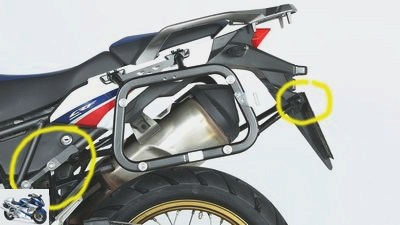
mps photo studio
18/39
The pannier rack itself (250 euros) disappears quickly thanks to the Quick-Lock system and, apart from two brackets (see circles), looks almost completely without leaving any residue. Conclusion: larger and more stable cases than the series counterparts.

mps photo studio
19/39
Need more protection? SW-Motech offers a stable engine protection that extends far up and over the flanks (230 euros).

mps photo studio
20/39
Touratech is offering a slimmer version with plastic protectors (249 euros).
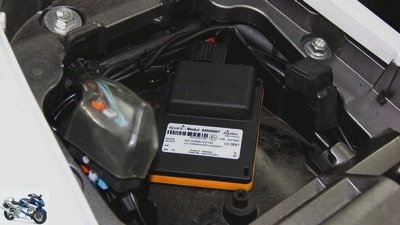
mps photo studio
21/39
eCall emergency call system: dguard, 479 euros: Detect a fall and get help automatically or locate the motorcycle in the case of thieves – dguard can do that.
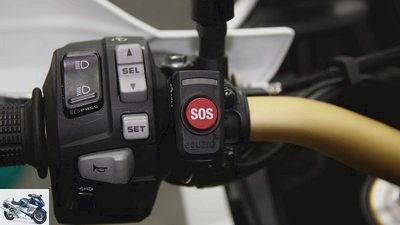
mps photo studio
22/39
Since the eCall system from Zittau has been monitoring our endurance test Africa Twin, the fleet manager has always known where the Honda is. Fortunately, the smart thing didn’t have to report an accident. Conclusion: a very clever idea.
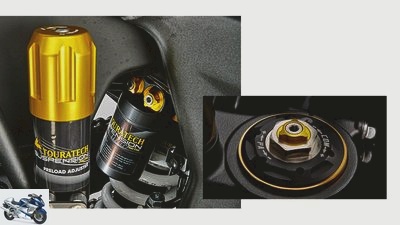
mps photo studio
23/39
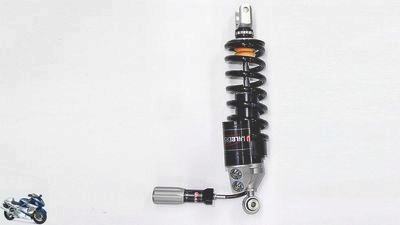
mps photo studio
24/39
Suspension: Type 642 from Wilbers, 1,078 euros: Larger adjustment range, different spring options – that’s what makes the Wilbers Monoshock appealing. However, the shock does not achieve the plush driving feeling of the Touratech monoshock. Conclusion: more reserves, but not more comfort.
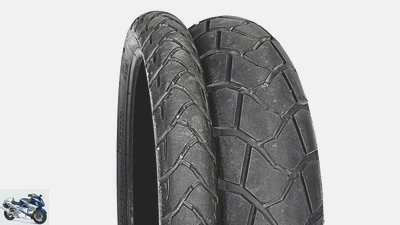
mps photo studio
25/39
Anlas Capra R: The tire from the Turkish manufacturer, which was only tested on dry surfaces, is irritating due to its crumple driving experience. The feedback remains diffuse in an inclined position, the limit of adhesion can only be felt vaguely. After just 50 kilometers, the cheap tire (172 euros / set) began to flake on the profile edges.

mps photo studio
26/39
Continental TKC 70: The more offroad-oriented tread pattern allows the tire to flex more and thus impairs steering precision. With enough grip, the Conti is still in good shape. It only appears more wobbly than the Trail Attack 2 on more extreme slopes. In wet conditions, however, it even stands out better.
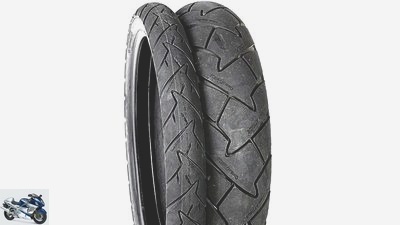
mps photo studio
27/39
Continental Trail Attack 2: The Conti immediately builds enormous trust. First-class feedback and a neutral driving behavior characterize the Trail Attack 2. It also cuts a fine figure when it comes to handling and provides a good feeling down to the deepest lean angles. Only the high level of wear and tear and the moderate wet grip dampen the enthusiasm.

mps photo studio
28/39
Dunlop Trailmax D 610: Above all, the front rubber, which is wobbly when sloping, spoils the driving pleasure on the series tires of the Africa Twin. He wanders to the outside of the curve on bumpy asphalt. The feedback also remains diffuse. The grip reserves are okay in dry conditions, but the D 610 behaves treacherously in wet conditions.
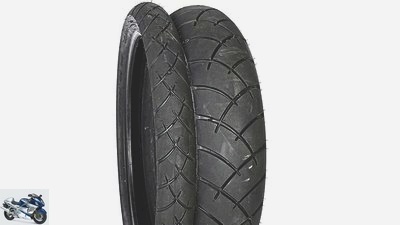
mps photo studio
29/39
Dunlop Trailsmart: The brand-internal alternative to the original Africa Twin tires. Positive: When it is wet, the Trailsmart has greater grip reserves than the D 610. However, when leaning it is even more wobbly than the standard tires. In the travel enduro tire test (MOTORRAD 11/2016), the Dunlop was also easy to wear.
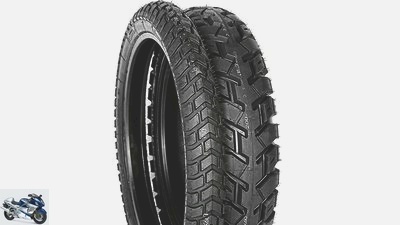
mps photo studio
30/39
Heidenau K 60 Scout: In terms of price, the K 60 (165 euros / set) undercuts the entire test field. Like the Anlas and Shinko, MOTORRAD only drove the Saxon tires on dry roads. There it steers neutrally and offers acceptable grip. Probably due to the rough profile is the tendency to break out of the rear when braking hard.
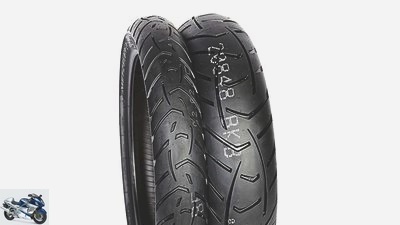
mps photo studio
31/39
Metzeler Tourance Next: With its pronounced neutrality, the Tourance Next fits the Africa Twin like a fist on the eye. Compared to the agile Trail 2 of the sister company Pirelli, the Metzeler relies on even quieter straight-line stability, but acts a little more sedate in curves. The wet grip is excellent and there is little wear.
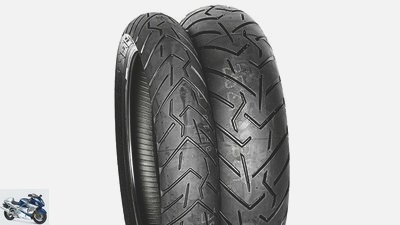
mps photo studio
32/39
Pirelli Scorpion Trail 2: The Pirelli shone across the board in last year’s MOTORRAD tire test (issue 11/2016). He also shows his qualities on the Africa Twin. Excellent grip on both dry and wet roads, smooth straight-line stability and, on top of that, little wear. A clear MOTORCYCLE practical tip.
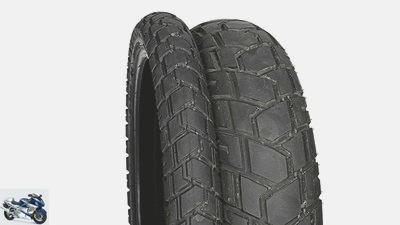
mps photo studio
33/39
Shinko Trailmaster E 705: Like the Anlas and Heidenau, MOTORRAD only drove the Korean Shinko on dry roads. The E 705 was inconspicuous there, but tends to collapse when the vehicle is tilted. Noticeable: the Shinko reacts to strong braking with a clear whimper and the tendency to break away at the rear.
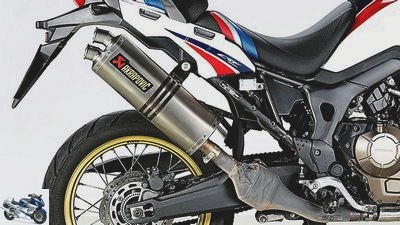
mps photo studio
34/39
Akrapovic Titan: The excellent manufacturing quality of the Slovenian cult manufacturer is legendary. The high-quality finish of the titanium damper is also pleasing. Matching: the fastening clip made of carbon. At the bottom of the speed cellar, the Akrapovic also ensures a livelier start. Against this background, you can get over the proud price of 739 euros. The double tube look of the end cap remains a matter of taste. Weight: 3.2 kg, power: 97 hp, price: 739 euros.
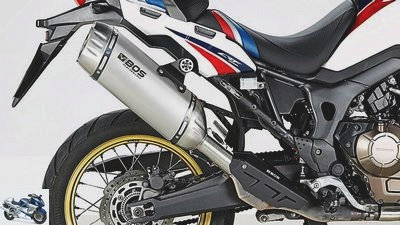
mps photo studio
35/39
Bos: With the best finish, the stainless steel silencer from the Dutch manufacturer impresses right away. The extension is a bit tricky, but ultimately the system can be installed without tension. The heat protection supplied in the footrest area is also well made. Also pleasing: In the lower speed range (up to 6,000 rpm) the exhaust provides more pressure. But quality costs. At 799 euros, the Bos is the most expensive silencer. Weight: 4.9 kg, power: 98 hp, price: 799 euros.
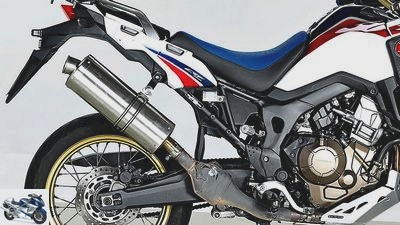
mps photo studio
36/39
Hashiru: With the competitive price of 249 euros, chain store Polo is sending the exhaust of its own brand Hashiru into the race. The stainless steel silencer is unadorned, but of good quality. Nevertheless, the extension is not possible without tension. In terms of performance, the damper emphasizes the medium engine speed range, but remains below the series counterpart up to 4,000 rpm. With its 2.6 kilograms, it saves around 45 percent of the weight of the standard damper (4.8 kg). Weight: 2.6 kg, power: 95 hp, price: 249 euros.
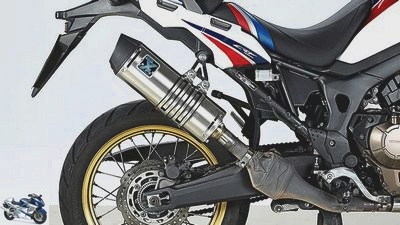
mps photo studio
37/39
IXIL Hexoval Xtrem Evo: The Spanish manufacturer presents its stainless steel system under the bulky name Hexoval Xtrem Evolution. The damper is well made and looks good too. However, the attachment with two rubber-backed clamps – as with the Termignoni damper – is quite fiddly. A tension-free attachment does not succeed. On top of that, the Honda with the IXIL loses torque in the lower speed range (3,500 to 5,500 rpm). Weight: 3.9 kg, power: 94 hp, price: 379 euros.
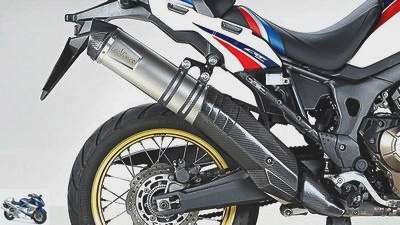
mps photo studio
38/39
Leo Vince: The Italian system sets itself apart with the large carbon cover. The stainless steel damper itself, including attachments (carbon clamps), is very valuable. Even sockets and sleeves make a high-quality impression. The attachment succeeds without tension. Because the Leo Vince also spices up the speed range between 4,000 / min and 6,000 / min, that’s enough for the MOTORRAD practical tip. Weight: 3.2 kg, power: 97 hp, price: 559 euros.

mps photo studio
39/39
Remus Okami: At 2.8 kilograms, the Austrian silencer is one of the lightweights. With only two parts (damper, holder), the system is foolproof pre-assembled. The fit is excellent. In the matt black version, the stainless steel case is quite sensitive to scratches. A less sensitive uncoated variant is available, however. However: In the lower speed range, the Remus damper costs a little power. Weight: 2.8 kg, power: 95 hp, price: 437 euros.
Honda CRF 1000 L Africa Twin
Experience over 50,000 kilometers
The Honda Africa Twin has been running the MOTORRAD endurance test since April 4, 2016 and has now completed the full distance of 50,000 kilometers. You can find the final balance here. We’ll also tell you in the video what is important when buying a used Africa Twin.
Our 50,000 km endurance test of the Honda A.frica Twin can with a clear conscience be described as an uneventful long-distance test. What sounds boring ultimately means accolade for an endurance test motorcycle. Especially since – especially in the case of the Africa Twin – uneventful cannot be equated with unemotional. The Honda was already causing excitement when a mud-encrusted prototype was shown at the Milan trade fair in autumn 2014. The photos of the two-cylinder in rally outfit went around the world, and the field for the hype about the comeback of the grande dame of the travel enduro segment was set. Twin fever was even rampant in the MOTORRAD editorial offices: when test boss Gert Thole returned enthusiastically from the presentation of the production model a year later, travel editor Markus Biebricher and reporter Mike Schumann each blindly ordered a private Africa Twin. It convinces – the asphalt riders with a relaxed roadholding, the tunnel knights with the best off-road capabilities of all two-cylinder enduros, the doubters with the limited use of electronics and the fans with their successful look.
Video: Used advice on the Honda Africa Twin
Over half with dual clutch transmission
From a standing start, the new Honda Africa Twin jumped to fifth place in the registration statistics and crept up to fourth place in 2017. Interesting: 52 percent of Africa Twin buyers ordered the bike with the automatically shifting dual clutch transmission despite an extra charge of 1,000 euros and an additional ten kilograms. And our long-term test motorcycle? Unwinded the kilometers in a hurry. Defects? Anyone who expects “none” as an answer is wrong. There were even notable ones.
Because what went on strike on the long-term test twin also gave up on some other Honda Africa Twin. The rear wheel bearings, for example. They are not undersized, maybe not sealed well enough. Like the starter button on the right handlebar switch. This ensured a long troubleshooting phase and therefore – probably unnecessarily – exchanged spark plug connectors. You often hear about leaking fork seals, but rarely about a stiff clutch cable that has therefore been replaced. The broken nose for draining the air filter box is ultimately more due to a faux pas when screwing or fiddling with the long-term test machine than to a material defect.
equipment
Seldom before has MOTORRAD tested more accessories in the interim endurance test than for the Honda Africa Twin. The best tires: Conti Trail Attack 2, Metzeler Tourance Next and Pirelli Scorpion Trail 2. The best retrofit silencers: Bos and Leo Vince. Jungbluth cushions a long-term, comfortable bench, inventor Wolfgang Roth devised a clever, customizable windbreak, and the GPS-based anti-theft protection and emergency call from dguard allows the twin to be located on a smartphone with thieves or after a fall. Also a good idea. The transmitter even signaled the mechanics’ test drives after the inspections to fleet manager Tobi Wassermann. We have put together all the accessories in detail for you in our picture gallery.
Inspections
The costs were initially within reasonable limits: 159 euros for the 1,000 kilometer initial inspection, 235 euros for the 12,000 inspection and 325 euros for the 36,000 service. It was precisely the recalibration of the dguard that caused the 24,000-kilometer inspection to swell to 834 euros. The final workshop visit after 48,000 kilometers also had a painful impact. Including the cost of new brake pads, the bill came to 868 euros. With an average consumption of 5.5 liters, the Honda Africa Twin was at least frugal in terms of fuel consumption. Many owners even report consumption of less than five liters.
The last gear of the Honda Africa Twin on the dissecting table of the MOTORRAD workshop was also remarkable. The twins from colleagues Biebricher (4,700 km) and Schumann (13,500 km) paid their last respects to the endurance test machine with a two-man trellis. The result of the autopsy: harmless tracks, little wear, all parts in the green area. The Honda Africa Twin would probably have lived a long time. With a loss of only 37.1 percent, it also achieved the second best value of all endurance test machines ever driven by MOTORRAD, behind the Harley-Davidson Road King.
Balance after 50,000 kilometers
Cylinder head: An outlet valve and an inlet valve are slightly leaking. The compression, however, has hardly decreased. The valve guides and stems are in good condition. There are harmless running tracks on the camshaft bearings. The exhaust valves and their seats have only slight traces of fire.
Cylinder / piston: The cylinders and pistons show hardly any signs of wear apart from a few harmless traces of friction, as do the piston rings.
Crank drive: Normal running tracks are visible on the connecting rod bearings, the bearing play is within the tolerance. The crankshaft main bearings show a somewhat asymmetrical contact pattern, the bearing play is also okay.
Power transmission: The gear wheels and shafts as well as the gearshift mechanism show hardly any wear apart from slight traces of engagement on the gearshift claws. The clutch steel disks are discolored, but not warped. The clutch springs have settled a bit.
Frame / chassis: The frame and add-on parts show signs of wear corresponding to the mileage, the swing arm and steering head bearings are free of play.
Honda opinion
… to the broken drainage nose on the air filter box:
This is certainly an isolated case and probably caused by an assembly error. We are not aware of any damage of this type.
… to the defective rear wheel bearings:
The warehouses complained about were not submitted to us for examination. In terms of warranty, the wheel bearings on the Africa Twin models are inconspicuous on the market.
… to the defective starter button:
This problem was quickly recognized and remedied with a modified switch unit. The lubricant of the switch and the contact pressure of the engine stop switch have been increased. Our dealers have been informed of this by circular.
… to the leaky fork seals:
Investigations on leaky forks revealed that these vehicles had been driven for a long time with heavily soiled forks. We cannot understand a quality problem, which is confirmed by our guarantee figures.
… to the quickly sagging bench:
This complaint is completely unknown to us. Neither quality monitoring nor customer service were contacted with such complaints.
… to the corroding spokes:
Corroded spokes are replaced without any problems under guarantee. The new spokes are coated twice. From model year 2018, stainless steel spokes will be used.
… to the request for a larger tank volume:
It is difficult to find a good compromise between range and weight or dimensions. The new Adventure Sports version of the Africa Twin has a tank volume that has been increased to 24.2 liters.
… to the wishes for a firmer shock absorber for better passenger suitability:
The Africa Twin chassis was designed for a wide range of applications. On- and off-road suitability, single-seater and two-seater operation and suitability for travel both with and without luggage. Due to this multitude of possible applications, compromises have to be made in the design.
… about the wishes for tubeless rims:
The ability to be repaired is of course in the foreground with such a type of vehicle. That is why Honda decided on spoked wheels with tubular tires when designing the Africa Twin.
Reading experiences
Gerhard Etlinger: I ordered and paid for the Africa Twin without having sat on it, let alone driven. I immediately fitted crash bars from African Queens and Cobbra Nemo chain oiler. The speedometer currently shows more than 20,000 km, including 3,000 km with a pillion passenger. A trip to the corn field at around 70 km / h was also included. Set up, bend the crash bar a little, and continue driving. I was very satisfied from the start. Little things, such as the spokes no longer shining, don’t bother me. If I can drive 130,000 km again in ten years with as few problems as with the Varadero, then I’ll be happy.
Thorsten Gudegast: It’s been 4,500 km with the new Africa Twin. I gave my XRV 750 for them after 14 years. For me, the new CRF 1000 is clearly better in terms of performance, stability and braking performance. The anti-skid control works great, as does ABS. The old twin is much more agile. Care: Dismantling the side panels and the front paneling on the old Africa Twin takes ten minutes, on the new one it takes 40 minutes. One of the original suitcases couldn’t stand falling over while standing. My previous Hepcos Juniors took harder blows. I think the new Africa Twin won’t stay with me for 14 years. It’s a solid machine, but not as multifunctional as the XRV. During this year’s trip through the Alps, we often talked about the fact that the CRF wrongly received such good press reports.
Andreas Jorn: The Africa Twin is my 47th motorcycle. I covered a good 10,000 kilometers with her. In addition to the many good features, there are also a few downsides: In my opinion, the spring of the rear shock absorber is quickly overwhelmed in pillion operation. The processing no longer seems to do justice to the legendary Honda image. The heated grips have been repaired three times so far. The left handlebar armature was replaced as well as the wheels, which were marred by rusty spokes. What remains is a tank logo that has fallen off in the Spanish sun. Tip: If the handlebars are covered with dark foil between the risers, this increases the readability of the instrument cluster.
Kai-Uwe Och: I moved the Africa Twin a good 25,000 km, and it was almost completely problem-free. She never let me down. It is made for Scandinavia, here the travel enduro gets species-appropriate floor housing. The chassis impresses on bumpy country roads with and without asphalt. The known teething troubles of the corroding spokes and the hanging set button were resolved by Honda without discussion. And: I’ve been riding the first set of Heidenau K60 Scouts for 22,000 kilometers!
Andreas Hess: I live in Thailand and drive an Africa Twin DCT. The switch from the scooter succeeded straight away thanks to the famous DCT. Within three months I unwound a good 5,000 km. The moped is absolutely heat-resistant, the engine temperature does not rise even at an estimated 50 degrees and stop-and-go in downtown Bangkok. I am very satisfied. In mountainous terrain – here it is sometimes 20 percent – being able to shift downhill manually is a great help. Improvements? A height-adjustable disc, proper footrests and a socket in the cockpit are suggestions for a product upgrade.
Markus Hellstern: My experience from 37,000 km with the Africa Twin: First of all I have to say that I think the motorcycle and especially the engine and the (manual) gearbox are great – if it weren’t for that annoying and sometimes dangerous “hobbling” of the front fork. When driving straight ahead and at an incline between 50 and 85 km / h, the front of the vehicle behaves as if it were a strong imbalance or a strong lift on the front wheel. The front wheel and the tires were checked often and by several authorities – no finding. Slight improvements were achieved by lowering the air pressure at the front, the softest fork setting, and “pushing through” the fork legs (8 mm). All those involved, including the importer, consider the fork’s breakaway torque too high to be the cause. Honda calls this “state of the art” and sees no need for improvement.
Price comparison Honda Africa Twin
Here we have listed current offers and a price overview for the Honda CRF1000L Africatwin. We have all versions (with and without DCT) as well as the Adventure Sports in comparison.
Price comparison for used Honda CRF1000L Africa Twin
1000PS marketplace app
The variety of used Honda Africa Twins is great.
Since its return, the Honda Africa Twin, this time with the abbreviation CRF 1000 L, has been a real hit on the used market. The range is large and the selection of different configurations varied. With or without DCT, full of accessories or still standard – used Honda Africa Twins are available in every version. Here is a price comparison for used Honda Africa Twins: used Honda CRF1000L Africa Twin in Germany.
Related articles
-
Endurance test Honda CBR 1000 RR Fireblade SC77
Jorg Kunstle. 19 pictures Andreas Bildl 1/19 The ignition lock of the Fireblade no longer wants to give up the key – a little oil helps. Volkmar Jacob 2/19 …
-
Driving report Honda CRF 1000 L Africa Twin (part 1)
Honda 13 photos ULA SERRA PRATS 1/13 Honda Africa Twin. 2/13 270 degree crank pin offset, long, continuous shaft with two balance weights in front of the…
-
www.factstudio.de 16 photos www.factstudio.de 1/16 Picture gallery: Impressions of the new Honda Africa Twin and Werner Mini Koch’s very own twin story….
-
Honda Gold Wing GL 1800 endurance test final balance
Jacek Bilski 34 photos ADAC 1/34 I’ve never taken apart an engine that looked this good, everything here looks more like 5,000 than 63,000 kilometers….
-
Honda Africa Twin in the top test
markus-jahn.com 21st photos markus-jahn.com 1/21 The first impressions of the Honda Africa Twin when it was presented were promising. But now it applies….
-
Endurance test Honda CBR 600 F
Bilski Endurance test Honda CBR 600 F Luck ?? she was gone A Honda CBR 600 F visits the MOTORCYCLE endurance test at regular intervals. The latest…
-
Honda Africa Twin, KTM 1050 Adventure and Suzuki V-Strom 1000
markus-jahn.com 33 photos archive 1/33 Power on the crankshaft. Measurements on the Dynojet roller test stand 250, corrected according to 95/1 / EG,…
-
markus-jahn.com 21st photos markus-jahn.com 1/21 The first impressions of the Honda Africa Twin when it was presented were promising. But now it applies….
-
Honda CRF 1100 L Africa Twin (2020) in the driving report
Motorcycle fair in Milan EICMA 2019 Presented by Honda 14th photos Honda 1/14 The base model Honda CRF 1100 L Africa Twin comes exclusively with the…
-
Endurance test final balance MZ 1000 S
Bilski endurance test final balance sheet MZ 1000 S To be or not to be The world had to wait a long time for the sporty 1000 from Saxony. In the first endurance test …